Every year we make adjustments in an effort to get better at everything
we do on the farm. Sometimes, we change varieties we grow. Often, we
make small adjustments in how grow to adjust to the weather and
circumstances on the farm. We may grow more or less of something based
on the anticipated demand. Of all of the crops we grow, lettuce (and
greens) have the most flexibility within our growing systems.
The
truly wonderful thing about lettuce is its relatively short period of
time from seeding to maturity. We can grow many successions of lettuce
in one season, which means we might be able to adjust to late requests
for certain varieties. If one succession fails, there is almost always
another one in the pipeline. Our best season in recent years saw us
being able to harvest fresh lettuce for 16 of the 20 CSA weeks in our
farm share program.
A few terms or notes for the interested:
Heads
of lettuce: When we refer to 'heads' of lettuce, we are referring to
ONE plant. We are not claiming that the variety is a head lettuce. Most
of our varieties are looseleaf, butterhead, crisphead, batavian or
romaine. Do not confuse this term with the heads of lettuce that are in
the iceberg family (something we do not typically grow).
Holding
qualities in the field: When we make a note that a variety holds well in
the field, we are indicating that plants will be of harvestable quality
over a longer period of time without bolting or getting bitter. Some
types, such as Gold Rush, tend to need picking over a short period of
time once they reach mature size. Others, such as Crispmint, can easily
maintain quality for periods up to three weeks. Many lettuces will hold
in the Fall during the shorter days and cooler weather. Holding quality
is much shorter in the Summer months.
Bolting: Lettuce is
said to 'bolt' when the plant begins to tower (or get tall with a heavy
stem) in an effort to produce seed. For many varieties, bolting occurs
when the weather is too warm for the cultivar. In some cases bolting
will be promoted when plants are too close or weed pressure is high.
Competition can force bolting. Lettuce that 'bolts' typically has a
taste that is more bitter than lettuce that has not bolted. This does
not mean the lettuce is not edible, it just means that taste is not at a
peak and may not be tolerable for many persons. Some lettuces, such as
Grandpa Admires and Australian Yellow Leaf, tend to have thicker stalks
and may give the appearance of bolting before the quality is greatly
changed. We often will taste a variety in the field prior to picking it
to make sure it does not have a bitter aftertaste. If it does, we will
use that as a benchmark to determine which others of that type are no
longer marketable. The good news is that turkeys and chickens like
lettuce even after it has bolted or gotten bitter.
Ice Queen (Reine des Glaces)
Ice Queen is an heirloom variety that we have grown since at least 2010. Some folks refer to this sort of lettuce as a crisphead, but I refer to it as a Batavian type. They do form a loose head in the center and they do have a crunchy/crisp texture for persons who like that sort of thing in their lettuce (people like Tammy!). The color is almost a blue-green in some light conditions.
 |
| Reine des Glaces |
This lettuce tends to have a 'clean' flavor that matches up with the 'crisp' texture nicely. In our opinion, the flavor is not strong. Ice Queen is rated as being able to handle warmer temperatures (as with most Batavians) fairly well, but we normally don't like to grow it beyond June and won't start new until mid-August.
Bronze Arrowhead
This has been one of our favorite lettuces on the farm since the beginning. This oak-leaf variety handles all sorts of weather and can hold well in the field. It has a distinct taste and slightly softer texture for persons like Rob who prefer that sort of thing.
 |
| Bronze Arrowhead |
One of the things we like about Bronze Arrowhead is that, while it has a stronger lettuce taste, it stays on the right side of bitter far longer than most lettuces. If you think the standard iceberg lettuce is the way lettuce should taste (as in - it has NO taste), then you might be overwhelmed by Bronze Arrowhead at first. But, then, you'll recognize that it is ok for lettuce to have a taste and may find it difficult to ever go back.
Bronze Arrowhead is greener during warmer weather and redder during colder weather. While we don't grow it as a cut and come again harvest, a person could start a few plants and harvest leaves for an extended period of time.
Bunte Forellenschus/ Bunte Forellenschluss
This variety has crawled up the charts of our favorite lettuce varieties over the past five years. Part of that has to do with finding the right time slots and situations to successfully grow this lettuce. With more growing success comes more opportunities to assess the taste and qualities of the lettuce. Apparently, it has not disappointed since we keep adding it to our grow list every season.
 |
| Bunte Forellenschluss |
Some people might notice the two spellings and wonder about it. Our seed comes from Seed Savers and the name spelling change merely comes from them. While we have not spent time figuring out why this change occurred, we can guess that it had to do with some verification research on their part for the origins of this heirloom lettuce.
Bunte qualifies as a butterhead type with softer leaves and beautiful red/brown speckling on the leaves. While we think it is a beautiful lettuce, we have had trouble with people misinterpreting the speckling as problems with the lettuce leaves. Honest, they are supposed to look like this!
This lettuce falls into Rob's top two for favorite lettuce taste/texture combinations. Rob prefers smoother leaves that don't tend to 'crunch' when you eat them. Maybe a better way to put it is that Rob prefers spinach to lettuce if he can get it. Lettuces such as Grandpa Admires and Bunte Forellenschus cater to that preference by having textures that are closer to spinach and tastes that are sweeter, for lack of a better description.
Grandpa Admires

One of our favorites to grow, harvest and eat. Grandpa Admires would be classified as a looseleaf or buttercrunch type of lettuce. This variety is more heat tolerant than most, so it usually appears in our CSA shares in July and even August. It also grows just fine in the fall, but it tends to have much more red in it at that time and is much more compact. The taste is likely a bit sweeter in the Fall as well. Large leaves with a softer texture. Excellent for sandwiches. If it gets a little 'wilty' in the fridge after a week, revive it with a quick soak in cold water. If you don't like softer lettuces, you won't like Grandpa Admires. If you don't like 'harder' lettuce textures, you'll love this one. We were surprised how well this variety did in the high tunnel, with decent heads holding until December. We have not tried to overwinter this variety. Grandpa Admires will sometimes 'tower' without resulting in bitter leaves. If flower heads start, that is usually the point that the taste rapidly declines. We will plant Grandpa Admires for five successions most growing seasons.
Crispmint

Crispmint is an all season romaine. It holds up pretty well in the summer months, though the edges might brown (this is known as tip burn). We've overwintered these under a low-tunnel (plastic) and they take off once the weather warms in March. These can produce big (1/2 to 1 lb) heads that are very crisp, but in some conditions it will produce a looser head with less weight. In that case, the taste and leaf quality is still fine - even if it is not the size and shapre you hope for. CSA members have given a strong 'thumbs up' on taste for this variety since it was introduced. There are claims that the leaves get sweeter the closer to the center you get - and like most romaines, that can be ALOT of leaves. A reliable crop, enjoyable to pick, impressive to put on the market/CSA table and they hold in the field well. This is one we used to highly recommend for all purposes. Sadly, it seems that higher demand has led to poorer quality in the seed stock. We are considering selecting for some of our own seed in the future. We have noticed that romaines at full size do not hold as well in a high tunnel, with outer leaves breaking and dying and inner leaves freezing and staying frozen. It's in the nature of the plant. But, small plants will overwinter just fine. Crispmint will show up in five or six successions every season. We are exploring other romaine options to alternate with it.
Australian Yellow Leaf

This is one of our summer lettuces that is very slow to bolt and produces very impressive "heads" with very large leaves. In this case, a head is more of a stalk with nice big lightly savoyed leaves. Soft leaves, generally mild flavor. This, and Grandpa Admires are two lettuces that are fun to grow, beautiful to look at, can get some good size (so make sure you transplant with a little extra space - or thin - to prevent bolting), and if you put transplants in rather than direct seeding, you can get very nice reliable crops. We have noticed that heavy rains or winds tend to make these plants look "sad" with the large outer leaves laying down (on the ground or drooping). At this point, you need to pick this crop before the leaves lose their quality. They will look fine (and taste great) once picked, soaked and given a quick shake to get the leaves to realign (one of the things you can do with a soft leaf). If left too long, you can still pick the smaller leaves off the top. The lower leaves will lose their marketability (but will taste good enough in your own salad) since the light green color can go from interesting to sickly looking when damaged. We grow this lettuce one to two times per season.
Amish Deer Tongue

This lettuce is a little harder to describe because it is very different than many we grow. The leaves have a spinach-like texture, and that texture suggests spinach enough that some people might detect a hint of spinach taste. We're not sure if that's inferred or actual. The taste and texture are just different enough that they add interest to a salad with more commonly known lettuces. Plants are compact and tough. Probably a better cool season lettuce as they don't hold long in warmer weather. Note: don't plant too close or you'll get tall/thin plants that aren't as full as they can or should be. Crowding due to overplanting or weeds will encourage bolting. And, unlike other lettuce, storm damaged leaves don't just 'melt' away as the plant grows through the damage. As a result, storm damaged plants are often difficult to market because of their looks. We expected these to do well in the high tunnel and they did do well enough. But, like a romaine, they don't unfreeze like looseleaf lettuces might. So, target them for November to early December (at the latest) in Iowa, but don't try to push it too far or you lose quality. A good variety to add for different texture and taste in the salad. We are growing this variety less often because conditions have to be perfect to get the best looking heads. We won't mind growing it if asked, but it doesn't make the rotation often otherwise.
Forellenschus

A beautiful spotted leaf romaine that does a great job in the early summer months. Hitting the timing for a fall planting is a bit trickier than some. These produce full and often heavy (1/2 to 1#) heads of lettuce, though we will often harvest smaller as the heat increases. They grow well during the summer - but you do have to watch to make sure they don't show signs of bolting - once they show any sign of it - they're going to go through the bolting process within 24-36 hours. Excellent all-around romaine. We have found that this lettuce may need an education component for sales. The brownish/purple spots are often misconstrued as 'bad spots' on the lettuce - much to the detriment of the seller (and the buyer who doesn't bother to ask, taste, or otherwise check out this variety). Once tried, people will ask specifically for this one. We did notice that this romaine handled life in the high tunnel better in December than the other varieties. It also overwintered well (get them to about 2-3 inches tall around Nov 5 and they'll hold there). We try to get two good successions in the Spring to Summer slot and will try to strike lightning in a bottle with a succession or two in the Fall. We don't usually try it during summer months.
Pablo

Pablo has rapidly become a favorite of ours. This variety forms loose heads as they approach maturity, but can be harvested younger as a leaf lettuce. They are longer season (60 to 70 days) and hold very well in the field. The biggest thing this variety has going for it is the taste. Many people reported taking tastes of the lettuce head as they prepared a salad, only to find that the entire head was eaten before the salad was fully prepared. Beautiful plants with big outer 'loose' leaves and a moderate sized 'head.' You can plant these relatively close and not have to worry about bolting. The only 'knock' on these plants is the relative fragility of the stems on the transplants. As a result, you will benefit from avoiding overcrowding each tray cell (so you don't have to tease seedlings apart and risk breaking them). If you direct seed, then you have to be careful about accidently breaking plants you want to keep when you thin. Good response to high tunnel growing in the fall. Not necessarily the best candidate to overwinter. These can also be a little harder to clean and prepare since they hold alot of water in the center. We still love this lettuce, but they don't seem to be growing as well as they used to and we wonder if there is an issue with the seed strain purity? We still try to put Pablo in the ground at least four times a season.
Gold Rush

This one is definitely a colder season lettuce. Once the daylight hours get longer and the weather gets warmer, it tends to bolt quicker than many of our varieties. On the plus side, it is very cold tolerant and doesn't show much damage after overnight freezes. It can be overwintered if covered and is a good candidate for late fall planting for early spring emergence. Very ruffled, light green leaves. Very attractive on sandwiches or salads. Tends to have a 'firmer' texture. Heads don't hold together as well as some varieties, but that means you won't get as much stalk as you will with others. Reasonably good high tunnel production in the fall. It is possible that they will hold longer than others, but they were all picked before we could test that theory. We did find that they host aphids better than most lettuces - even though it takes a while before the leaves are damaged. We have also noted that seed does not keep very well. So, don't buy too much extra and expect to use it the next season. This one is grown only at the very edges of the season in the coolest weather.
Magenta
 |
| Magenta lower part of photo |
We grew this as part of a Summer lettuce trial in 2017 and we liked the
results, so it returns in 2018. These are a very dense leaf lettuce that
is reddish in coloration. This one fits the standard taste often found
for large leaf lettuce put on burgers and other sandwiches in
restaurants. It's not exotic, but it sure is a work horse. It will start
showing up in late July and should run late into the season.
Winter Density
Don't let the picture at the left influence you too much. We don't always get the camera out when plants are at their peak. In this case, we pulled it out after a harvest/delivery and these were the ones that were left in for too long. They exhibit some tip burn on the edges of the leaves. However, I can tell you that they tasted very good at the moment the picture was taken because I sampled them after the photo op!
We've grown this one now for two years and we like the
heavy green heads with heavy leaves. The texture is literally 'dense'
and it reminds us a little of spinach texture. They hold well in the
field and the taste remains mild even after they begin to bolt. They do
have some issues with tip burn in warmer weather, but this variety also
shows potential for being nearly as flexible as Bronze Arrowhead.
Other Lettuces We Grow
The following are lettuces we are trying out and have more limited experience with them. We will do our best to describe them here:
Nevada - 2018 is a first time trial for Summer lettuce. It is likely to be another heavy lettuce, like Magenta, but it will be a solid green. We will try to give more information as we gather it.
Bergam's Green - also part of the 2018 trial. The description sounds like it would be Nevada if you add savoying and wavy borders to the leaves.
Concept - a summer crisp type that is also in the 2018 trial. It is said to have some romaine characteristics.
Parris Island Cos - Here is one of our attempts to find a companion romaine for Crispmint. These should be very large green romaine heads. Early returns look very promising.
Red Romaine - We are trying to find a Red Romaine that produces better than Rouge d'Hiver. We are targetting later in the year for this variety.
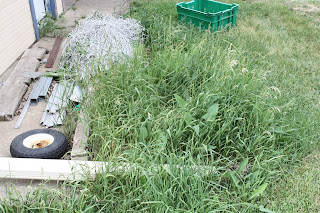

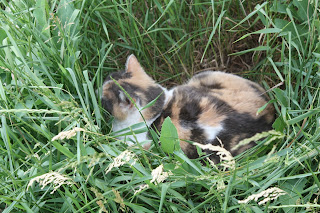











 One of our favorites to grow, harvest and eat. Grandpa Admires would be classified as a looseleaf or buttercrunch type of lettuce. This variety is more heat tolerant than most, so it usually appears in our CSA shares in July and even August. It also grows just fine in the fall, but it tends to have much more red in it at that time and is much more compact. The taste is likely a bit sweeter in the Fall as well. Large leaves with a softer texture. Excellent for sandwiches. If it gets a little 'wilty' in the fridge after a week, revive it with a quick soak in cold water. If you don't like softer lettuces, you won't like Grandpa Admires. If you don't like 'harder' lettuce textures, you'll love this one. We were surprised how well this variety did in the high tunnel, with decent heads holding until December. We have not tried to overwinter this variety. Grandpa Admires will sometimes 'tower' without resulting in bitter leaves. If flower heads start, that is usually the point that the taste rapidly declines. We will plant Grandpa Admires for five successions most growing seasons.
One of our favorites to grow, harvest and eat. Grandpa Admires would be classified as a looseleaf or buttercrunch type of lettuce. This variety is more heat tolerant than most, so it usually appears in our CSA shares in July and even August. It also grows just fine in the fall, but it tends to have much more red in it at that time and is much more compact. The taste is likely a bit sweeter in the Fall as well. Large leaves with a softer texture. Excellent for sandwiches. If it gets a little 'wilty' in the fridge after a week, revive it with a quick soak in cold water. If you don't like softer lettuces, you won't like Grandpa Admires. If you don't like 'harder' lettuce textures, you'll love this one. We were surprised how well this variety did in the high tunnel, with decent heads holding until December. We have not tried to overwinter this variety. Grandpa Admires will sometimes 'tower' without resulting in bitter leaves. If flower heads start, that is usually the point that the taste rapidly declines. We will plant Grandpa Admires for five successions most growing seasons.
 Every decision of this nature has a domino effect. One of the dominoes is that the planting in Eden for the Summer crops went in later than we wanted. They'll be fine, of course. Just not the schedule we hoped for. There are tomatoes on the far left with lettuce next to them. Beets are seeded next to peppers. Onion and melons in the center. Peppers and green beans next followed by lettuce and tomatoes on the right.
Every decision of this nature has a domino effect. One of the dominoes is that the planting in Eden for the Summer crops went in later than we wanted. They'll be fine, of course. Just not the schedule we hoped for. There are tomatoes on the far left with lettuce next to them. Beets are seeded next to peppers. Onion and melons in the center. Peppers and green beans next followed by lettuce and tomatoes on the right.




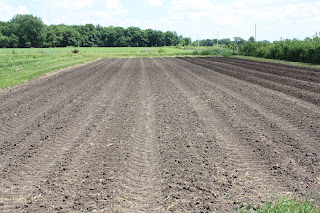
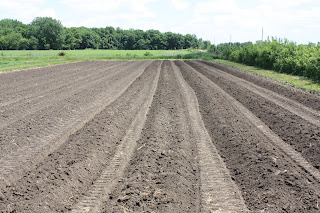
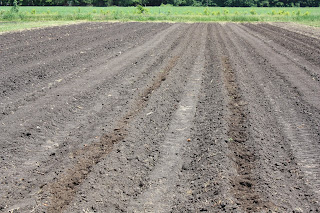



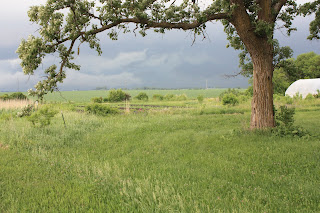

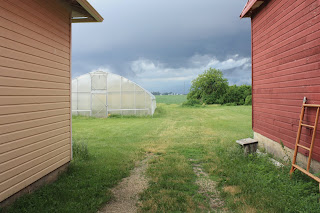
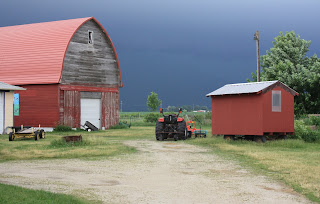

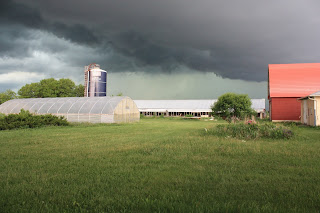



 This year, much of the 'bruising' and fatigue is mental. We are trying to catch up after the weather enforced a late start on the farm and then it jumped to mid-Summer mode. This has resulted in some interesting early season crop challenges that will require some adjustments. Add to the mix an early (and more difficult than usual) blackfly/buffalo gnat explosion during some of the hottest days and you have a recipe for a little bit of farmer disgruntling. We've always wondered about the word 'disgruntled.' Disgruntled usually indicates grumpiness, dissatisfaction, etc etc. But, gruntling SOUNDS more like you shouldn't be happy, but the dictionary tells me it means "pleased or satisfied." Well, whatever. We have NOT been pleased with the blackflies since both of us have had bites all over our arms and some on our necks, ears, etc.
This year, much of the 'bruising' and fatigue is mental. We are trying to catch up after the weather enforced a late start on the farm and then it jumped to mid-Summer mode. This has resulted in some interesting early season crop challenges that will require some adjustments. Add to the mix an early (and more difficult than usual) blackfly/buffalo gnat explosion during some of the hottest days and you have a recipe for a little bit of farmer disgruntling. We've always wondered about the word 'disgruntled.' Disgruntled usually indicates grumpiness, dissatisfaction, etc etc. But, gruntling SOUNDS more like you shouldn't be happy, but the dictionary tells me it means "pleased or satisfied." Well, whatever. We have NOT been pleased with the blackflies since both of us have had bites all over our arms and some on our necks, ears, etc.